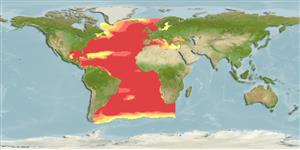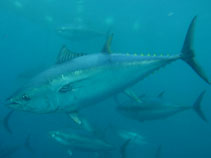Masukkan pemerhatian anda di Fish Watcher
| Native range | All suitable habitat | Point map | Year 2050 |

|
| This map was computer-generated and has not yet been reviewed. |
| Thunnus thynnus AquaMaps Data sources: GBIF OBIS |
muatnaik fotos/gambar dan video
Pictures | Videos | Stamps, coins, misc. | imej GoogleThunnus thynnus
Picture by Ticina, V.
Pictures | Videos | Stamps, coins, misc. | imej GoogleThunnus thynnus
Picture by Ticina, V.
Common names from other countries
klasifikasi / Names Nama-nama umum | Sinonim (persamaan) | Catalog of Fishes(Marga, Jenis) | ITIS | CoL | WoRMS | Cloffa
> Scombriformes (Mackerels) > Scombridae (Mackerels, tunas, bonitos) > Scombrinae
Etymology: Thunnus: Greek, thynnos = tunna (Ref. 45335).
More on author: Linnaeus.
Etymology: Thunnus: Greek, thynnos = tunna (Ref. 45335).
More on author: Linnaeus.
Environment: milieu / climate zone / depth range / distribution range Ekologi
laut; payau; oceanodromus (Ref. 51243); kisaran kedalaman 0 - 985 m (Ref. 55291), usually 0 - 100 m. Subtropical; 3°C - 30°C (Ref. 88796); 69°N - 58°S, 99°W - 42°E
Penyebaran Negara-negara | Daerah-daerah FAO | Ecosystems | Kemunculan | Point map | Introduksi | Faunafri
Western Atlantic: Labrador and Newfoundland to Gulf of Mexico, and Caribbean Sea to Venezuela and Brazil. Eastern Atlantic: Lofoten Islands off Norway to Canary Islands, including the Mediterranean and the southern part of the Black Sea (Ref. 6769). Reported from Mauritania (Ref. 5377). There is a subpopulation off South Africa. Highly migratory species.
Length at first maturity / Size / Weight / umur
Maturity: Lm 103.5, range 97 - 110 cm
Max length : 458 cm TL jantan/; (Ref. 26340); common length : 200 cm FL jantan/; (Ref. 168); Berat maksimum terpublikasi: 684.0 kg (Ref. 26340); Umur maksimum dilaporkan: 32 Tahun (Ref. 5810)
Max length : 458 cm TL jantan/; (Ref. 26340); common length : 200 cm FL jantan/; (Ref. 168); Berat maksimum terpublikasi: 684.0 kg (Ref. 26340); Umur maksimum dilaporkan: 32 Tahun (Ref. 5810)
deskripsi pendek Kunci identifiaksi (pengenalan) | Morfologi | Morfometrik
Duri punggung (Keseluruhan (total)) : 12 - 14; duri punggung lunak (Keseluruhan (total)) : 13 - 15; Duri dubur: 0; Sirip dubur lunak: 13 - 16; vertebrata, bertulang belakang: 39. A very large species, deepest near the middle of the first dorsal fin base. The second dorsal fin higher than the first; the pectoral fins are very short, less than 80% of head length. Swim bladder present. Lower sides and belly silvery white with colorless transverse lines alternated with rows of colorless dots. The first dorsal fin is yellow or bluish; the second reddish-brown; the anal fin and finlets dusky yellow and edged with black; the median caudal keel is black in adults. May be confused with several other tunas, these are typically much smaller and easily distinguished by specific patterns of stripes, bands or dots.
Oceanic but seasonally coming close to shore. They school by size, sometimes together with albacore, yellowfin, bigeye, skipjack etc. Visual predators (Ref. 88866) preying on small schooling fishes (anchovies, sauries, hakes) or on squids and red crabs. Live up to 40 years in the western Atlantic (Ref. 88822). Weight up to 900 kg (Ref. 88823). Eggs and larvae are pelagic (Ref. 6769). Juvenile growth is rapid (about 30 cm / year) but slower than in other tuna
and billfish species (Ref. 88867). Adult growth is considerably slower, with about 10 years needed to reach two thirds of maximum length. Become rare because of massive overfishing (Ref. 35388).
Life cycle and mating behavior Kematangan | Reproduksi, perkembang biakan | Pemijahan | telur-telur | Fecundity | Larva
Oviparous batch spawner, with an inter-spawning interval of 1-2 days in the Mediterranean Sea (Ref. 88871). Females larger than 205 cm fork length are estimated to have a mean fecundity of 30-60 and 13-15 million eggs, in the western and eastern Atlantic respectively (Ref. 40805, Ref. 88871). Spawning occurs when sea surface temperatures are between 22.6-27.5 ºC and 22.5-25.5 ºC in the Gulf of Mexico and Mediterranean Sea respectively (88868). Spawning occurs between June and August in the Mediterranean Sea (Ref. 88868). Eggs are released directly to the water column and hatch after 2 days (Ref. 88823). At 24°C, embryo development lasts about 32 hours and larval stages about 30 days. Egg size 1.0 mm, larval length at hatching 2.8 mm.
Spawning grounds are mainly known from the Gulf of Mexico and the Mediterranean Sea, but the presence of mature individuals and larvae far from these areas (e.g. Bahamas and central North Atlantic Ocean) suggest that other spawning grounds may also be utilized (Ref. 88873, Ref. 88874, Ref. 88872). Appears to display homing behaviour with (western-tagged individuals migrating back to specific spawning sites either in the Gulf of Mexico or the Mediterranean Sea) (Ref. 88872, Ref. 88870). Fidelity to natal areas seem to occur once individuals reach maturity, i.e. after returning to either the western or eastern spawning grounds (Ref. 88868).
rujukan utama
Upload your references | Acuan | Koordinator : Collette, Bruce B. | mitra
Collette, B.B., 1999. Mackerels, molecules, and morphology. p. 149-164. In B. Séret and J.-Y. Sire (eds.) Proc. 5th Indo-Pac. Fish Conf., Noumea, Paris. (Ref. 33246)
Status IUCN Red List (Ref. 130435: Version 2024-2)
kurang bimbang (LC) ; Date assessed: 15 January 2021
ancaman kepada manusia
Harmless
penggunaan manusia
Perikanan: komersial; Budidaya air: komersial; Ikan buruan: ya
FAO(Aquaculture systems: production; Perikanan: production, profail spesis; publication : search) | FIRMS (Stock assessments) | FishSource | Sea Around Us
informasi lanjut
Population dynamics
Growth parameters
Max. ages / sizes
Length-weight rel.
Length-length rel.
ukuran frekuensi
Mass conversion
pemulihan
Kelimpahan
Growth parameters
Max. ages / sizes
Length-weight rel.
Length-length rel.
ukuran frekuensi
Mass conversion
pemulihan
Kelimpahan
Physiology
Body composition
Nutrients
Oxygen consumption
Swimming type
Swimming speed
Visual pigments
Fish sound
Diseases & Parasites
Toxicity (LC50s)
Body composition
Nutrients
Oxygen consumption
Swimming type
Swimming speed
Visual pigments
Fish sound
Diseases & Parasites
Toxicity (LC50s)
Alat, peralatan
Bio-Quiz | E-book | Penuntun lapangan | Kunci identifiaksi (pengenalan) | tanda freqkuenci panjang | peringkat sejarah hidup | peta titik | Classification Tree
| Catch-MSY |
laporan khas
muat turun XML
Sumber internet
Aquatic Commons | BHL | Cloffa | BOLDSystems | Websites from users | semak peneliti ikan | CISTI | Catalog of Fishes(Marga, Jenis) | DiscoverLife | ECOTOX | Faunafri | Fishtrace | GenBank(genom, Nukleotida) | GloBI | GOBASE | | Google Books | Google Scholar | Google | IGFA World Record | MitoFish | Pangkalan data nasional | Otolith Atlas of Taiwan Fishes | Akuarium publik | PubMed | Reef Life Survey | Scirus | SeaLifeBase | Tree of Life | Wikipedia(pergi, Cari) | World Records Freshwater Fishing | Zoological Record
Estimates based on models
Preferred temperature (Ref. 115969): 7.5 - 24.7, mean 12.6 (based on 3084 cells).
Phylogenetic diversity index (Ref. 82804): PD50 = 0.5039 [Uniqueness, from 0.5 = low to 2.0 = high].
Bayesian length-weight: a=0.01230 (0.01003 - 0.01509), b=3.03 (2.99 - 3.07), in cm Total Length, based on LWR estimates for this species (Ref. 93245).
Trophic level (Ref. 69278): 4.5 ±0.8 se; based on diet studies.
Daya lenting (Ref. 120179): sedang, Waktu penggandaan populasi minimum 1.4 - 4.4 tahun (tm=3-5; tmax=15; Fec=10 million).
Prior r = 0.24, 95% CL = 0.16 - 0.35, Based on 5 full stock assessments.
Fishing Vulnerability (Ref. 59153): Very high vulnerability (82 of 100).
Climate Vulnerability (Ref. 125649): Moderate vulnerability (38 of 100).




